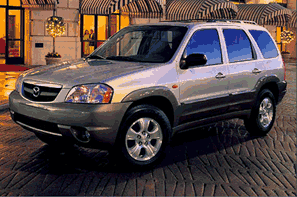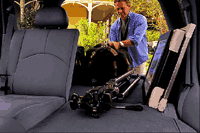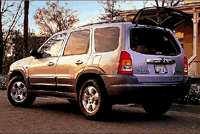Mazda Tribute (2001)
|
Mazda Tribute(2001) |
|
|
Ford owns Mazda, and here was Ford's problem: The Explorer's average transaction price was quickly heading up to 30 grand. Meanwhile, there are lots of people who want "Explorer-like vehicles" who have only 20 or 25 grand to spend. And instead of Ford products, they're buying things like the Nissan XTerra, the Honda CR-V, and the Toyota RAV4. Ford had simply priced itself out of this more "basic" SUV market. In addition, people were increasingly seeking more-carlike SUVs, having finally soured on trucklike vehicles. So, working with Mazda, they came up with the Tribute (also sold as the Ford Escape with some slight variations). The Tribute is smaller than the Explorer, but hardly small. And it's based on the Mazda 626 car platform, which, in part, accounts for its good handling and road manners. Ford and Mazda did a good job. The Tribute is capable, versatile, and bigger than the "small" SUVs like the RAV4 and Honda CR-V. It's closer in size to the XTerra, which is almost as big as a Ford Explorer. It's big enough for what most people will use it for: three other people and some "stuff." And, with a cars.com target price of $20,745 with a V6 engine and four-wheel drive, it's not a bad deal. The base Tribute comes with a four-cylinder engine, a five-speed standard transmission, and front-wheel drive. A V6 engine and four-speed automatic and four-wheel drive are optional. The model we test-drove had all these options. The stick shift is unavailable in the V6 or in four-wheel drive. |
|
 |
Like the Honda CR-V and the Toyota RAV4, the Tribute leans more toward being a car than previous Ford trucks. It's built on a unibody platform rather than the body-on-frame construction used for truck-based sport utilities. As a result, the Tribute handles well. It never made us feel that we were in danger of capsizing during normal around-town driving. It was nice to drive an SUV and not have to "prepare to come about" on turns. You just slow down normally and drive through turns as you would with a car. No need to slow to 4 mph just to turn a corner. The ride is also better than truck-based SUVs. The Tribute did not make unpremeditated lane changes at every bump in the road. The Tribute has what Mazda calls four-wheel drive -- which is actually probably closer to all -- wheel drive than true four-wheel drive. How does it work? In the normal mode, the Tribute is a front-wheel drive vehicle. The dashboard "4wd" switch locks the vehicle in four-wheel drive for a limited amount of time if the rotary blade coupling senses wheel slip. It's not a true differential lock in the style of traditional four-wheel drive, since it allows some differential action between the front and rear axles. The availability of the 200-horsepower, three-liter V6 sets the Tribute apart from the RAV4, the CR-V, and the station-wagon-like Subaru Forester, all of which come only with four-cylinder engines. The six-cylinder engine is more than adequate without being overpowering, and we suspect it's a better choice than the four. However, drivetrain noise is still quite noticeable, though that may be as much a sound-insulation issue as an engine issue. It's hard to tell. Whatever the reason, you hear the engine quite clearly when driving. It's no cocoon. The Tribute is wider than you might expect, giving it a spacious feel. It felt bigger inside than the spacious Honda CR-V, although it's actually five inches shorter. For its length, the Tribute is wide -- wider, in fact, than the larger 2001 Ford Explorer. (In that respect, it fit us well. We, too, have been told that we're wide for our length.) |
 |
Headroom and legroom up front are abundant, and even the back seat is surprisingly adequate. Out back, you can raise the entire rear door, or just the glass if you like. There's room in the way-back for 31 cubic feet of Labrador retriever or peat moss -- about the same as a CR-V and a little less than a Forester.
Standard features on the four-wheel-drive Tribute include air conditioning, an AM-FM CD player, and power windows and door locks. Side-impact air bags and antilock brakes are lumped together in a single $495 safety package. |
 |
|
 |
The Tribute's styling is in the mold of the larger Ford Explorer and the very successful Nissan XTerra (although not as Gen-X'ed as the XTerra). It looks like a basic SUV. There's nothing high style about the Tribute, nor is there anything offensive about its looks. It looks good. It looks like what it is. |
 |
The Tribute uses Ford's tried-and-true V6 three-liter Duratec engine. It's mounted transversely; that is, the crankshaft is parallel to the axles. The design leaves a reasonable amount of room to work under the hood, although your mechanic will first have to remove the plastic shroud that pretty much covers up everything. The serpentine belt that powers the accessories looks like a snap to replace, and the water pump is externally driven, which means you don't have to remove the timing chain to replace it. By the way, this vehicle has a timing chain that should last the life of the vehicle, rather than a timing belt that has to be replaced at 60,000 or 90,000 miles -- at a cost of many hundreds of dollars. Change the oil and don't abuse the engine, and you should be able to get 150,000 miles out of it before the chain goes, as it inevitably will. (Our suggestion, of course, is to sell it to your brother just before that happens.) |
 |
View cars.com model report on this vehicle. |

 The Tribute was designed to be an "affordable" SUV. To make it affordable, some cheaper plastics and fabrics had to be used. The doors are a little thinner and the seats are a little less comfortable than we would have hoped for. But the Tribute doesn't feel cheap. Given the price, we think it's an acceptable compromise.
The Tribute was designed to be an "affordable" SUV. To make it affordable, some cheaper plastics and fabrics had to be used. The doors are a little thinner and the seats are a little less comfortable than we would have hoped for. But the Tribute doesn't feel cheap. Given the price, we think it's an acceptable compromise. The Tribute is fully compliant with the Federal Office for Beverage Preparedness, with its two cup holders up front. For stowing away little stuff, there's a small glove compartment and a bin at the bottom of the console.
The Tribute is fully compliant with the Federal Office for Beverage Preparedness, with its two cup holders up front. For stowing away little stuff, there's a small glove compartment and a bin at the bottom of the console.
